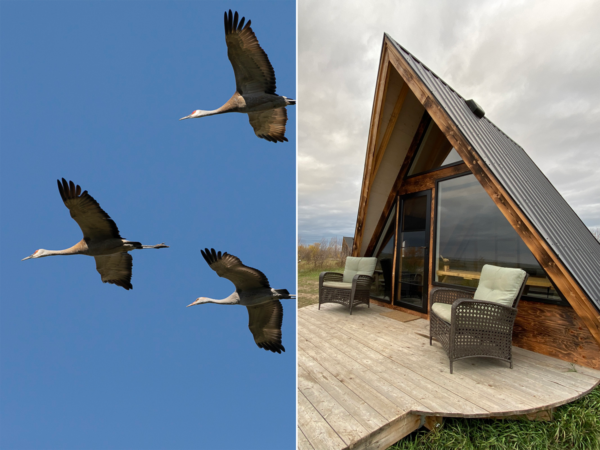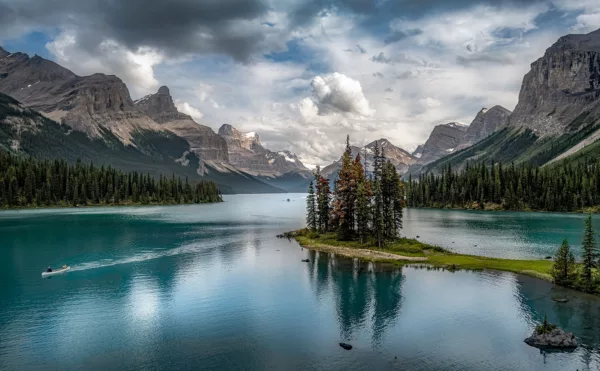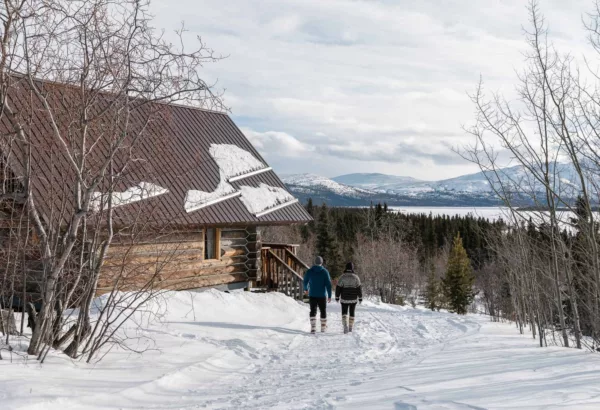40 Dark Sky Areas Across Canada

In past centuries, the night skies were a guiding light; they continue to be a fascination, whether nightly entertainment while hiking the backcountry or a regular search above for our planetary neighbours.
Here are 40 dark sky areas to explore across Canada:
West:

- McDonald Park Dark Sky Preserve: Found between Abbostford and Chilliwack in BC’s Fraser Valley, this park can boast about its views of the Milky Way. Designated in 2000, the preserve is is easily accessed and protected from city encroachment by mountains and protected land.
- Garibaldi Provincial Park: It’s a 22-kilometre challenge to hike to the Elfin Lakes hut, surrounded by the snowy peaks of the Coastal Mountains to witness unbelievable night sky views. Shorter hikes to Brohm, Cat or Levette Lakes also offer memorable places to view the heavens.
- Manning Park Resort: With multiple viewing areas, amateur astronomers will appreciate the opportunity to rent Celestron FirstScope telescopes on site. Dark sky devotees can benefit from discounted accommodation and year-round viewing opportunities.
- Mount Kobau: Located near Osoyoos in BC’s south Okanagan, this region has been hosting an annual star party for over 35 years. Every August, celestially-bound friends hike into the site to set up telescopes and talk stars for a week-long celebration.
- Miquelon Lake Provincial Park: Found within the immense 300 square kilometres of Beaver Hills, which was Alberta’s first dark sky preserve. Reserve ahead for one of four insulated yurts, which a deck perfect for a celestial viewing party.
- Lakeland Provincial Park: The newest dark sky preserve in wild rose country, this park offers the country’s only lake canoe circuit of four lakes covering 38 kilometres. Visitors can canoe to a shoreline to find a backcountry campsite to experience true darkness to skywatch.
- Jasper National Park: The largest national park in the Rockies, part of the UNESCO Canadian Rocky Mountain Parks World Heritage site and home to the Dark Sky Festival every October. Astrogeeks can meet astronauts, see star trails and learn secrets of the solar system.
- Cooking Lake-Blackfoot Provincial Recreation Area: Also part of the Beaver Hills dark sky preserve, there are several picnic areas to set up for an evening to gaze at the heavens. Keep an eye out for the Royal Astronomical Society of Edmonton who regularly meet here for star sightings.
- Grasslands National Park: This expansive dark sky preserve of 527 square kilometres has several optimal viewing areas to spot a shooting star. There are two car-accessible campgrounds: Frenchman Valley and Rock Creek, both with the hybrid tent-cabin oTENTik with a deck to set up for the night show.

- Cypress Hills Interprovincial Park: With over 650 campsites throughout this dark sky preserve, there are endless options to find a place to look for constellations. The park’s Dome Observatory has a 60-seat yurt classroom and observation platform for fans of the heavens to learn together.
- Old Man on His Back Prairie Heritage and Conservation Area: Made a nocturnal preserve in 2015, this prairie grassland is under the watchful eye of the Nature Conservancy of Canada.
- Spruce Woods Provincial Park: Head two hours west of Winnipeg to Manitoba’s first dark sky preserve chosen in 2020. Hike or take a horse into the backcountry mixed grass prairie landscape where the night sky will be unimpeded by any light pollution.
- Glenlea Research Station: Located at the University of Winnipeg and operated by the Winnipeg Centre of the Royal Astronomical Society of Canada, the station offers an observation site for members to set up telescopes and two on-site telescopes searching the starry night sky.
- Whiteshell Provincial Park: On the eastern edge of the province, this popular park offers a myriad of trails and opportunities far from the crowds to observe the skies. Consider the challenging Top of the World trail to the lookout to set up a telescope to peer at the Milky Way.
Territories:

- Midnight Dome: The pride of Dawson City, this location offers views of the Yukon River, Klondike Valleys and 180 degrees of sky. With approximately 518 metres (1,700 feet) of elevation gain, it also puts viewers a little closer to the vast areas of the cosmos.
- Yukon Centre Observatory: The only public astronomical centre north of 60 at Takhini Hot Springs, it’s possible to tick off many items from the astronomy bucket list. From the 700-metre-high observation deck, visitors can possibly see the Orion nebula, rings of Saturn, close-ups of the moon and solar storms.
- Wood Buffalo National Park: The world’s largest dark sky preserve at 44,000 square kilometres, there are endless places to observe on starry nights. Every August the park hosts the Dark Sky Festival at Pine Lake, to see the stars, moon, planets and the Northern lights.
- Aurora Village: Located on the outskirts of Yellowknife, guests have access to groomed trails and a sheltered area to witness the glory of the aurora borealis. Comfort-seekers will appreciate the warming teepee as well as heated seats that swivel 360 degrees for optimal viewing.
- Sylvia Grinnell Territorial Park: One kilometre from Iqualiut leads into this tundra valley, home to arctic wildlife and prime viewing of the aurora borealis. It’s worth it toss on the layers in the coldest months, as the clear nights make for optimal viewing of the heavens.
Central:

- Bruce Peninsula National Park: With minimal light pollution in this UNESCO World Biosphere Reserve, star seekers can watch the skies from the park’s popular stretch of sand, Singing Sands Beach. Hikers can follow the Bruce Trail to Stormhaven or High Dump camping areas to peek between the tall trees.
- Point Pelee National Park: Pick up a seasonal star chart from the park info centre and then head to serene West Beach for 180 degrees of night sky. Daytrippers can schedule their visit on the monthly Dark Sky nights, a once-per-month evening for constellation seekers to stay until midnight.
- Torrance Barrens Dark Sky Preserve: As the world’s first permanently designated dark sky reserve, dark sky enthusiasts will appreciate the numerous options for setting up telescopes on the solid bedrock of Canadian Shield. Located less than a two-hour drive from Toronto, this Muskoka locale makes it easy to get a dose of the solar system.
- Lennox & Addington County Dark Viewing Area: The most southerly star viewing site in Canada, this area was made specifically for star gazers with a telescope set-up area. Budding astronomers can access for free from dusk to dawn.
- Charleston Lake Provincial Park: South of Ottawa, this park is perfectly situated for casual night sky viewers with its amphitheatre seating, especially in the summer months during the annual Perseid meteor shower.
- Pourvoirie Saint Zenon: The first public astronomy observatory in Lanaudiere, this site opened in 2015, encouraging visitors near and far to come see the moon, stars and planets. Open year-round, the star-obsessed will appreciate the concrete area for telescopes and the Refuge de Vagabond, a waiting area until conditions are perfect.

- Mont Sutton: In Quebec’s Eastern Townships, Glen Sutton has embraced celestial viewings thanks to the mountain blocking light from nearby cities. Local resort Au Diable Vert hosts the ObservEtoiles, an AR-enhanced viewing of the night sky in an open-air amphitheatre.
- Mount Cosmos Observatory: South of Quebec City, this observatory hosts weekly constellation spotting events and also encourages solar observation, digital astrophotography and spectroscopy. Budding astronomers can access programs to encourage more devotees of exploring beyond our planet.
- Mont–Mégantic: The first international dark sky reserve. There are six trails designed for views of the skies above. In the Franceville section of this park, reserve one of the 10 ready-to-camp tents to focus all your time on dark sky explorations.
East:

- Herring Cove Provincial Park Reserve: Close to Halifax, this reserve’s look-off offers a panoramic view of the ocean coast and moon rise. It’s easy to enjoy constellations with a soundtrack of the Atlantic waves.
- Peggy’s Cove: World-famous for its lighthouse, the rocky shores of St Margarets Bay offer another opportunity to discover the night sky. With minimal light pollution in this coastal village, it easy to find the north star. Be careful and stay off the rocks.
- Sir Sanford Fleming Park: A 95-acre oasis close to downtown Halifax, the park’s Dingle Tower and nearby wharf offer perches for star enthusiasts to set up and gaze above to learn the secrets of the heavens.
- Kouchibouguac National Park: Located along the shores of New Brunswick’s Northumberland Strait, this has been a dark sky preserve since 2009. Thanks to minimal nocturnal lighting it’s easy to see stars from Kellys Beach boardwalk or the Claire-Fontaine trail loop.
- Kejimkujik National Park: The only dark sky preserve in Nova Scotia, night sky fans can visit the First Nations Sky Circle to learn about Mi’kmaq culture and their use of astronomy. The park also offers night hikes and night canoe trips for star lovers.

- Fundy National Park: Famous for its dramatic tides, the park’s trails lead to several areas where it is perfect to peep at the night sky. Head to the Butland Lookout or the Matthews Head Lookout where there’s a set of Park Canada red chairs to relax in while waiting for the moon and stars to appear.
- Irving Nature Park: This is Canada’s first urban star park, chosen by the Royal Astronomical Society of Canada. It’s a short drive from Saint John. Find a quiet spot to gaze at the heavens, especially when meteor showers are occurring.
- University of Prince Edward Island: The Astronomy department hosts public viewings once a month for young and old to gather to learn about the night skies and seasonal changes in what planets can be seen.
- Cornwall: This PEI town is teaching the next generation about dark skies thanks to the Sidewalk Astronomers of Charlottetown program, which outfitted six island libraries with telescopes. Cornwall residents can borrow a six-inch Dobsonian telescope from the library to start their star journals.
- Terra Nova National Park: Newfoundland’s first dark sky preserve is on the province’s Eastport Peninsula, a boreal forest providing several remote areas for night sky viewing. At the Malady Head campground, you’ll find tear-drop shaped Ôasis accommodation featuring skylights to see the stars.
- Battle Harbour: Formerly a fishing village, this Labrador town is truly off the beaten path, 14.5 kilometres from the next community in the Battle Islands. Among the 200-year-old buildings, it’s possible to star watch year-round.
- Gros Morne National Park: A UNESCO World Heritage site and national park, the Vikings were guided by the stars to the shores of this northern Newfoundland region 1,000 years ago. The Tablelands offer a dramatic backdrop to search the Milky Way.

PS. Why 40? Because Explore Magazine is Turning 40 Years Old!
In Spring of 1981, the first issue of Explore Magazine went up for sale on newsstands around Canada.
Forty years later, explore is still on newsstands coast-to-coast; we’ve expanded to create a unique subscription box, adventure-focused podcast and a trusted online magazine, drawing in readers from around the world.
Don’t forget to pick up your free e-book copy of the Top 40 Hiking Trails in Canada.
















